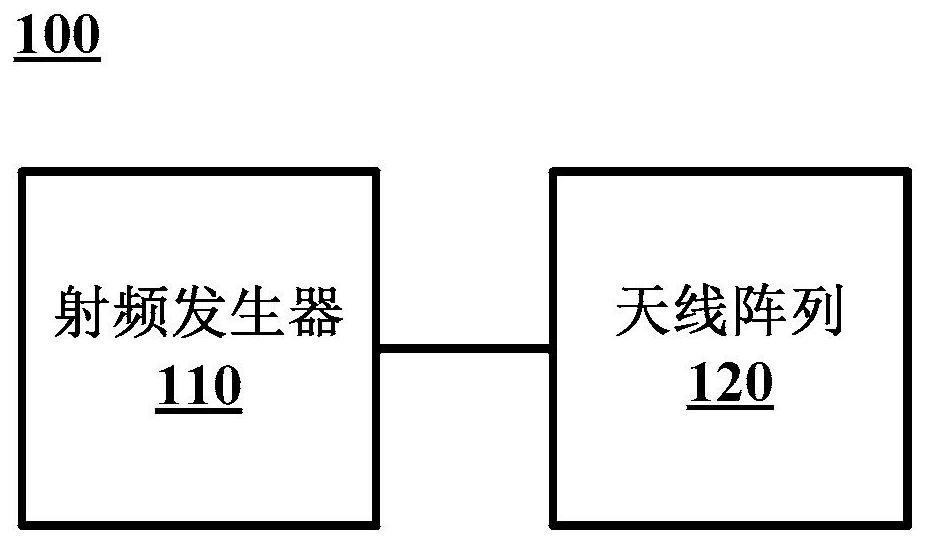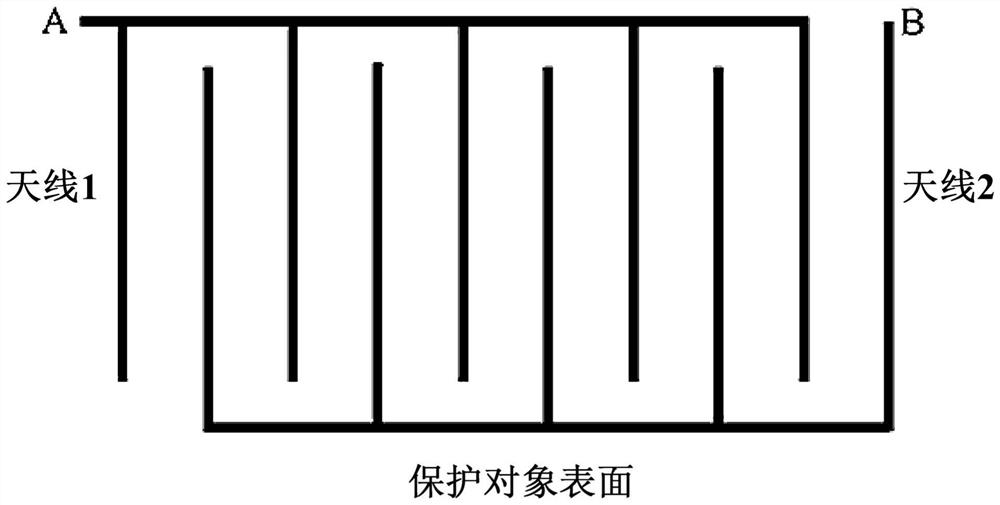Device and method for inhibiting biological attachment
A bio-fouling and biological technology, applied in chemical instruments and methods, pollution prevention methods, cleaning methods and utensils, etc., can solve the problems of high maintenance cost, reduced sailing speed, and difficult application, so as to reduce the probability of adhesion, Reduced distribution density, good inhibition effect
- Summary
- Abstract
- Description
- Claims
- Application Information
AI Technical Summary
Problems solved by technology
Method used
Image
Examples
Embodiment 1
[0056] In the first embodiment, the plane where the antenna array 120 is located is parallel to the surface of the protection object. like image 3 As shown, a cross-type antenna layout is used in this embodiment. Specifically, the antenna array 120 includes two groups of antennas ( image 3 Indicated as antenna 1 and antenna 2), each group of antennas includes a plurality of antenna wires that are parallel and spaced apart from each other, and the antenna wires of the two groups of antennas are alternately crossed to form an interdigitated structure. In application, the A terminals and the B terminals of the two groups of antennas are respectively connected to the radio frequency generator 110 (specifically, the power amplifier 112 ). Changes in the magnitude and direction of the voltage between terminals A and B will generate an alternating electric field between adjacent wires. The alternating electric field can generate an alternating magnetic field and form a local alt...
Embodiment 2
[0059] The difference between the second embodiment and the first embodiment is that in the second embodiment, a relative antenna array layout structure perpendicular to the surface of the protection object is adopted. like Figure 4 As shown, the plane in which the antenna array 120 is located is perpendicular to the surface of the protected object. The antenna array 120 includes two groups of antennas (antenna 1 and antenna 2), each group of antennas includes a plurality of antenna wires parallel and spaced apart from each other, wherein the antenna wires in each group of antennas are perpendicular to the surface of the protected object, and the antenna wires in one group of antennas are perpendicular to the surface of the protected object. Each antenna wire is arranged opposite to the corresponding antenna wire in the other group of antennas in a direction perpendicular to the surface of the protection object, and the adjacent ends of the two opposite antenna wires in the t...
Embodiment 3
[0062] The difference between the third embodiment and the second embodiment is that the antenna layouts that are perpendicular to each other are adopted in the third embodiment. like Figure 5 As shown, in the third embodiment, the plane where the antenna array 120 is located is perpendicular to the surface of the protection object. The antenna array 120 includes two sets of antennas (antenna 1 and antenna 2), and the two sets of antennas are perpendicular to each other, thereby generating electromagnetic waves with different polarization directions. E.g, Figure 5 The antenna wires in the upper and lower directions form the antenna 2, and the antenna wires in the left and right directions form the antenna 1. The propagation directions of the electromagnetic waves generated by the antennas 1 and 2 are parallel to the surface of the protected object, but their polarization directions (ie, the polarization directions) are perpendicular to each other. In applications, the regu...
PUM
 Login to View More
Login to View More Abstract
Description
Claims
Application Information
 Login to View More
Login to View More - R&D
- Intellectual Property
- Life Sciences
- Materials
- Tech Scout
- Unparalleled Data Quality
- Higher Quality Content
- 60% Fewer Hallucinations
Browse by: Latest US Patents, China's latest patents, Technical Efficacy Thesaurus, Application Domain, Technology Topic, Popular Technical Reports.
© 2025 PatSnap. All rights reserved.Legal|Privacy policy|Modern Slavery Act Transparency Statement|Sitemap|About US| Contact US: help@patsnap.com



